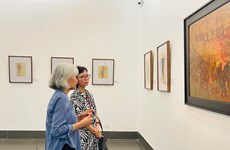Tram Tau highlands promoting cultural identity of Mong ethnic group
In her leisure time, Phàng Thị Khua from Tà Xùa hamlet in Bản Công commune often sits next to her family’s loom to weave brocade. The fabric is made from linseed, spun to make clothing for both Mong men and women.
The Mong people believe that regardless of gender or age, they must wear such clothing when they are buried. Therefore, from a young age, Mong women are taught how to weave by their mothers and grandmothers.
On normal days or holidays, Mong ethnic women are proud to wear their traditional outfits.
In Tram Tau district are teams making dresses to meet individuals needs or perhaps as gifts for family members getting married.
All Mong ethnic women, therefore, know how to make skirts and embroider dresses.
The outfits of the Mong ethnic minority in Tram Tau district are distinguished by the patterns, which feature scenes of nature and life. The main colour is red, which symbolises warmth and fullness and a desire to have a better life.
Over time, the ability to make outfits has become not so common among Mong ethnic women, but there are still ready-made outfits for women to embroider or decorate in their favourite patterns. This is not to say, however, that the basic features of outfits worn by Mong ethnic women in the past have been lost.
The Mong ethnic people in Tram Tau make up the majority of the district’s population, so local authorities are keen to preserve their cultural identity./













